FEATURES|THEMES|Music
The Kuchean Harp: Konghous in the Chinese Oasis Kingdom of Kucha
Buddhism filtered into China during the Han dynasty (206 BCE–220 CE) and, accompanying this ingress, diverse forms of Buddhist art gradually began to develop. Among the best visual sources for these arts are the many Buddhist grottoes that can still be found in parts of China. What is now Xinjiang Autonomous Prefecture was composed of several regions in ancient times, including Kucha, Bai-cheng, and Xinhe County. They were all situated in advantageous geographical locations and were regarded as important traffic hubs along the ancient Silk Road trade routes.[1] Records of the konghou or Kuchean harp first appeared in ancient Chinese literature from the Han dynasty, consistent with the introduction of Buddhism to China. However, pictorial materials, including images of other musical instruments, do not seem to have appeared until the 4th century CE.[2] The Buddhist grottoes of these ancient regions offer the most valuable and artistic representations and are of great research value.
There are nine major extant grottoes in Kucha, including the Kizil Thousand Buddha Caves and the Kumtura Thousand Buddha Caves in Aksu Prefecture, all built during the 4th–8th century CE. Artistic features shown in these grottoes, such as dance and musical performances, provide an important platform for understanding the interdependent relationship between the konghou and Buddhism, combined with their unique artistic features, and religious culture during ancient times.[3]
Form and structure of the konghou in Kucha
Two major types of konghou are depicted in the murals of ancient Kucha: the bowed konghou from India and the vertical konghou from Persia.[4] The bowed konghou is the most frequently depicted in Kizil grotto art, with only a few murals showing the vertical konghous that were used in the daily lives of Kuchean commoners.
Bowed konghous under the Indian system
The bowed konghou was often referred as the vina during India’s Gupta period (320–485). The vina was also known as the “glazed piano” in ancient China.[5] Its shape resembling that of a bow, it was introduced to Kucha along with Buddhism during the late 3rd century. One of the major differences between the bowed konghou and the vertical konghou was the resonance case of the latter, which was placed at the base. The primary material used for the bowed konghou was leather, while the vertical konghou was made of wood.[6]
 Indian-style vinas. From left to right: a vina in the Gupta period; a mural in Subashi Temple; and pottery figurine from the ancient kingdom of Khotan
Indian-style vinas. From left to right: a vina in the Gupta period; a mural in Subashi Temple; and pottery figurine from the ancient kingdom of KhotanThe second type of konghou was derived from Persian prototypes from the Sassanid Empire (224–651) in 226 CE. Examples can be seen in Caves 8, 17, 63, 80, 114, 175, 189, 192, 193, and 227 in the Kizil Grottoes, Cave 30 in the Kizilgaha Grottoes, Caves 23, 46, and 58 in the Kumtura Thousand Buddha Caves, Cave 20 in the Tuyugou Grottoes, and Cave 48 in Aksu Prefecture. In addition, this kind of vertical konghou image is also depicted on the relic box in Subashi Temple in Kucha, dated to the Tang dynasty (618–907). The crescent shape of the vertical konghou was slightly curved at the top as part of its resonating body. The sound holes were visible and the bottom part contained a wooden pedal that could be attached to a belt so that musicians could perform while sitting, standing, marching, or dancing,[7] and may be the reason why vertical konghous came to be widely used.[8]
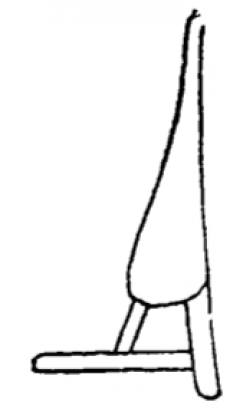 Vertical Konghou: Aksu Prefecture Cave 48
Vertical Konghou: Aksu Prefecture Cave 48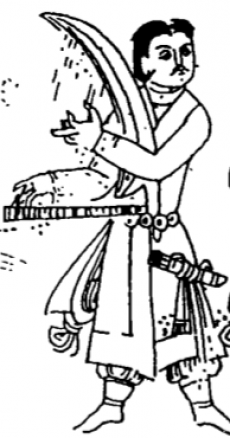 From the relic box in Subashi Temple
From the relic box in Subashi TempleThe Kuchean bowed konghou
The Kuchean bowed konghou is a variation on the Indian design. Its development represented a major step in the evolution of its design and tone enhancement. From the middle of the 4th century to the 7th century, the form and structure of the bowed konghou changed dramatically. They were no longer made with a conjoined shape, but instead were transformed into a longer round shape covered with leather, with strings tied directly to the bend. This vertical konghou was a clear improvement: containing a meniscus resonance case, the upper tip of the konghou was wider, and a supporting rod between the resonance case and strings was added. The crescent-shaped resonance case increased the number of strings, thereby expanding the range of tones.
 The bowed konghou. From left to right: a Kuchean bowed konghou; a typical bowed konghou from the Kizil Caves (3rd Century); from Cave 58 in Kumtura Thousand Buddha Caves
The bowed konghou. From left to right: a Kuchean bowed konghou; a typical bowed konghou from the Kizil Caves (3rd Century); from Cave 58 in Kumtura Thousand Buddha CavesMusical functions
Another unique characteristic of the Kuchean konghou can been seen in its musical functions in terms of the combinations of musical instruments in orchestras and the types of musicians depicted in grotto murals.
In the Kizil grottoes, konghous make up the majority of musical instruments depicted in the murals, and they are used in both vocal and orchestral music, as well as dance. Alongside 19 panpipes and 17 five-stringed pipa, 30 bowed konghous are depicted. This phenomenon reflects how plucked instruments were commonly used in Kucha and is consistent with the accounts of Chinese Buddhist monk, scholar, and traveler Xuanzang (c. 602–664) in his Record of the Western Regions.
 Kizil Cave 38, left, and Kizil Cave 238, right.
Kizil Cave 38, left, and Kizil Cave 238, right. Orchestra - Kumtura Cave 46, left, and konghou performed solo in the sky from Kumtura Cave 13, right
Orchestra - Kumtura Cave 46, left, and konghou performed solo in the sky from Kumtura Cave 13, rightThere were two ways to play the konghou: in the first, the musician would hold the instrument with one hand and pluck the strings with the other; the second way was to support the instrument in the armpit and pluck the strings with both hands while standing or dancing. According to the scholar Lin-qian (1899–1976), the latter method was likely an innovation of the Kucha people.[9] Performance posture and methods can be divided into five categories: 1) sitting, 2) standing, 3) combinations of sitting and standing depending on musical context, 4) the first three categories with vocal accompaniment, and 5) playing while flying. The contemporary Chinese scholar Huo Xu-chu points out that in depictions of gandharvas (a type of supernatural being) performing with konghous, a cross-legged sitting posture is common in murals in Kucha.[10] The many playing postures reflect the konghou’s high degree of adaptability; examples include dancing images depicted on the relic box in Subashi Temple.[11]
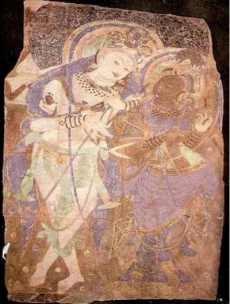 Kizil Cave 13
Kizil Cave 13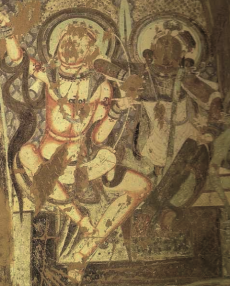 Kizil Cave 77
Kizil Cave 77Religious functions
The Buddhist stories and teachings depicted in murals in Kucha, which feature the konghou and other musical instruments such as the pipa, were instrumental in promoting Buddhism in a more expressive and nuanced way. For instance, the konghou was often performed in solo and ensemble forms and was exclusively performed by gandharvas as an expression of gratitude to the Buddha. Another form of offering is flower-scattering, one of the most important offerings in Buddhism. Therefore, to a large extent, konghou performances combined with flower-scattering also reflect the importance of the instrument’s role.[12]
 Flower-scattering - Kizilgaha Cave 30
Flower-scattering - Kizilgaha Cave 30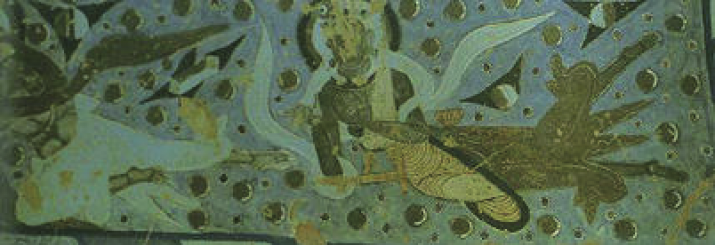 Music offering in Konghou - Kizilgaha Cave 30
Music offering in Konghou - Kizilgaha Cave 30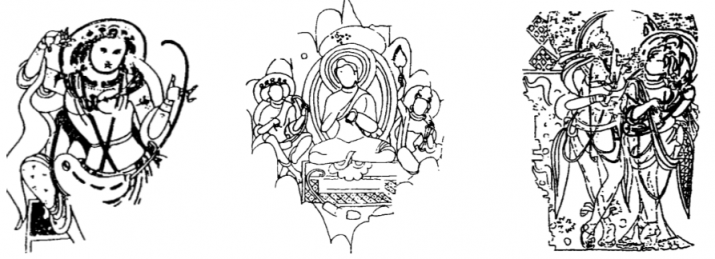 From left to right: gandhara performance on bowed Konghou; gandhara and attendant in Kizil Cave 196; gandhara and heavenly dancer in Kizil Cave 224
From left to right: gandhara performance on bowed Konghou; gandhara and attendant in Kizil Cave 196; gandhara and heavenly dancer in Kizil Cave 224Conclusion
The Kuchean Buddhist monk, scholar, and translator Kumarajiva emphasized the beauty and function of music for promoting Buddhism and his work reflected the affection for music among the people of Kucha.[13] In the Mahaprajnaparamita Sastra, he stated that music can soften one’s heart and can help sentient beings feel compassion. Kumarajiva also used the konghou as metaphor to explain the Buddhist teachings—such as the concept of emptiness and the law of origination. These konghou images in Kucha undoubtedly provide us with valuable and important references for the study of the history of Chinese music,[14] as well as the relationship between Chinese music and Buddhism.
[1] 中國音樂文物大系總編輯部,中國音樂文物大系新疆卷,鄭州:大象出版社,1999, p.132.
[2] 賀志凌,新疆出土箜篌的音樂考古學研究,中國藝術研究院,2005, p.1.
[3] 中國音樂文物大系總編輯部,中國音樂文物大系新疆卷,鄭州,大象出版社,1999, p.132.
[4] 李玫,箜篌變異形態考辨───新疆諸石窟壁畫中的箜篌種種,中國音樂學(季刊)第四期,1994, p.87.
[5] 林謙三,東亞樂器考,音樂出版社,1962, p.213.
[6] 何昌,林文,十四弦──鳳首箜篌,中國音樂學,1990, 第1期.
[7] 肖堯軒、劉文,克孜爾石窟壁畫中的彈撥類樂器及其組合研究,新疆大學學報(哲學、人文社會 科學版),第41卷第2期,2013, p. 74-75.
[8] 李玫,箜篌變異形態考辨───新疆諸石窟壁畫中的箜篌種種,中國音樂學(季刊)第四期,1994, p.87-89.
[9] 林謙三,東亞樂器考,北京:人民音樂出版社,1962, p.214.
[10] 霍旭初,龜兹乾達婆故事壁畫研究,敦煌研究,1990, p.27, 39.
[11] [1]肖堯軒、孫國軍,克孜爾石窟伎樂壁畫中的樂隊排列與樂器組合形式,新疆大學學報(哲學、人文社會科學版),第42卷第2期,2014, p.74.
[12] 肖堯軒、劉文,克孜爾石窟壁畫中的彈撥類樂器及其組合研究,新疆大學學報(哲學、人文社會科學版),第41卷第2期,2013, p.74.
[13] [1] 大智度論,卷99, 釋曇無竭品,第89上,大正藏卷25, p.7456.
[14] [1] 肖堯軒,克孜爾石窟伎樂壁畫之音樂信息解讀,新疆師範大學音樂學院,2011, p.4.
Related features from Buddhistdoor Global
Buddhism and Abundance: Monastery of Tranquillity and Peace (Jing’an Monastery) in Shanghai
Tam Po Shek and Wing Chi Ip: Refreshing the Soul and the Senses by Playing the Flute and Drinking Tea
The Hanging Sculptures of the Little Western Paradise














